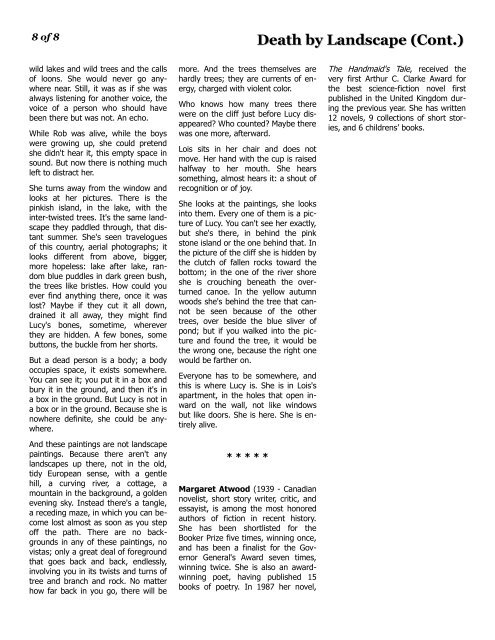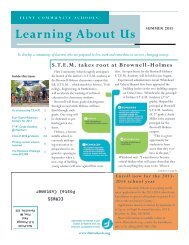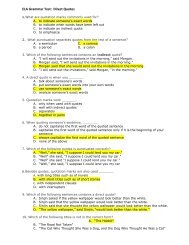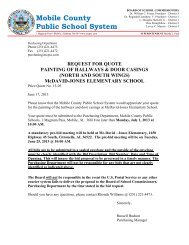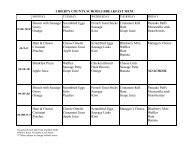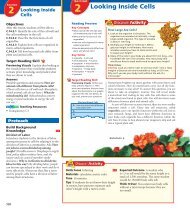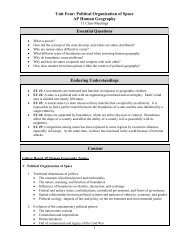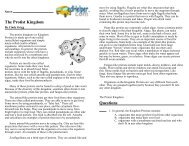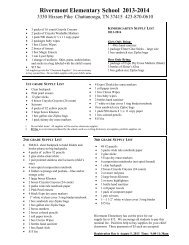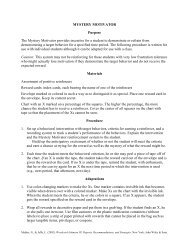Death by Landscape by Margaret Atwood - Baby's First Year
Death by Landscape by Margaret Atwood - Baby's First Year
Death by Landscape by Margaret Atwood - Baby's First Year
Create successful ePaper yourself
Turn your PDF publications into a flip-book with our unique Google optimized e-Paper software.
8 of 8 <strong>Death</strong> <strong>by</strong> <strong>Landscape</strong> (Cont.)<br />
wild lakes and wild trees and the calls<br />
of loons. She would never go anywhere<br />
near. Still, it was as if she was<br />
always listening for another voice, the<br />
voice of a person who should have<br />
been there but was not. An echo.<br />
While Rob was alive, while the boys<br />
were growing up, she could pretend<br />
she didn't hear it, this empty space in<br />
sound. But now there is nothing much<br />
left to distract her.<br />
She turns away from the window and<br />
looks at her pictures. There is the<br />
pinkish island, in the lake, with the<br />
inter-twisted trees. It's the same landscape<br />
they paddled through, that distant<br />
summer. She's seen travelogues<br />
of this country, aerial photographs; it<br />
looks different from above, bigger,<br />
more hopeless: lake after lake, random<br />
blue puddles in dark green bush,<br />
the trees like bristles. How could you<br />
ever find anything there, once it was<br />
lost? Maybe if they cut it all down,<br />
drained it all away, they might find<br />
Lucy's bones, sometime, wherever<br />
they are hidden. A few bones, some<br />
buttons, the buckle from her shorts.<br />
But a dead person is a body; a body<br />
occupies space, it exists somewhere.<br />
You can see it; you put it in a box and<br />
bury it in the ground, and then it's in<br />
a box in the ground. But Lucy is not in<br />
a box or in the ground. Because she is<br />
nowhere definite, she could be anywhere.<br />
And these paintings are not landscape<br />
paintings. Because there aren't any<br />
landscapes up there, not in the old,<br />
tidy European sense, with a gentle<br />
hill, a curving river, a cottage, a<br />
mountain in the background, a golden<br />
evening sky. Instead there's a tangle,<br />
a receding maze, in which you can become<br />
lost almost as soon as you step<br />
off the path. There are no backgrounds<br />
in any of these paintings, no<br />
vistas; only a great deal of foreground<br />
that goes back and back, endlessly,<br />
involving you in its twists and turns of<br />
tree and branch and rock. No matter<br />
how far back in you go, there will be<br />
more. And the trees themselves are<br />
hardly trees; they are currents of energy,<br />
charged with violent color.<br />
Who knows how many trees there<br />
were on the cliff just before Lucy disappeared?<br />
Who counted? Maybe there<br />
was one more, afterward.<br />
Lois sits in her chair and does not<br />
move. Her hand with the cup is raised<br />
halfway to her mouth. She hears<br />
something, almost hears it: a shout of<br />
recognition or of joy.<br />
She looks at the paintings, she looks<br />
into them. Every one of them is a picture<br />
of Lucy. You can't see her exactly,<br />
but she's there, in behind the pink<br />
stone island or the one behind that. In<br />
the picture of the cliff she is hidden <strong>by</strong><br />
the clutch of fallen rocks toward the<br />
bottom; in the one of the river shore<br />
she is crouching beneath the overturned<br />
canoe. In the yellow autumn<br />
woods she's behind the tree that cannot<br />
be seen because of the other<br />
trees, over beside the blue sliver of<br />
pond; but if you walked into the picture<br />
and found the tree, it would be<br />
the wrong one, because the right one<br />
would be farther on.<br />
Everyone has to be somewhere, and<br />
this is where Lucy is. She is in Lois's<br />
apartment, in the holes that open inward<br />
on the wall, not like windows<br />
but like doors. She is here. She is entirely<br />
alive.<br />
* * * * *<br />
<strong>Margaret</strong> <strong>Atwood</strong> (1939 - Canadian<br />
novelist, short story writer, critic, and<br />
essayist, is among the most honored<br />
authors of fiction in recent history.<br />
She has been shortlisted for the<br />
Booker Prize five times, winning once,<br />
and has been a finalist for the Governor<br />
General's Award seven times,<br />
winning twice. She is also an awardwinning<br />
poet, having published 15<br />
books of poetry. In 1987 her novel,<br />
The Handmaid's Tale, received the<br />
very first Arthur C. Clarke Award for<br />
the best science-fiction novel first<br />
published in the United Kingdom during<br />
the previous year. She has written<br />
12 novels, 9 collections of short stories,<br />
and 6 childrens’ books.


